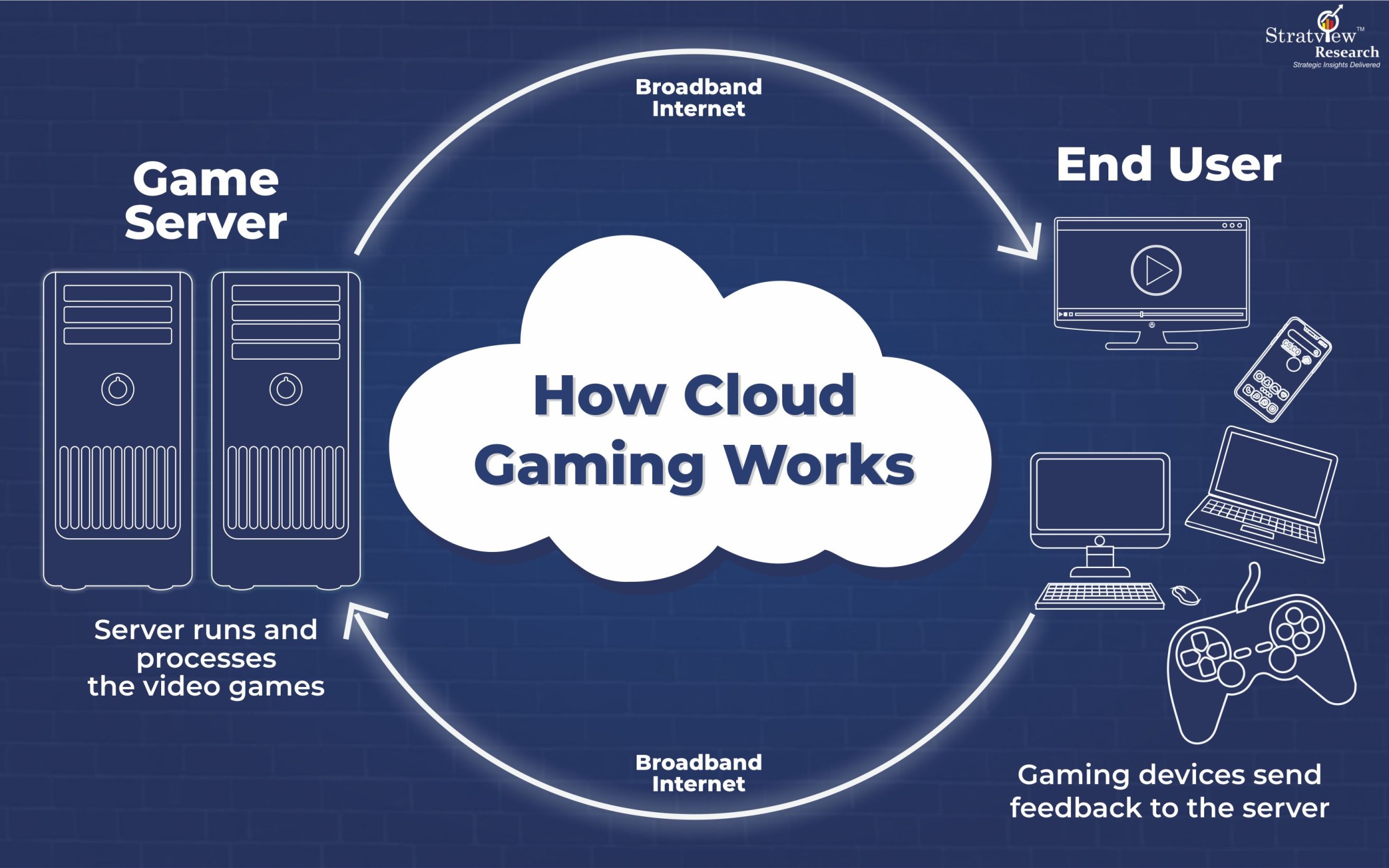From traditional mechanisms to emerging platforms, cloud gaming is transforming the way we perceive video games. As more people seek out the PS6 release date, and gaming tech itself is more readily adopted in society, it’s clear that the industry is changing at an alarming rate. Cloud gaming, utilizing recent streaming and AI innovations, is one of the most potentially disruptive forces in the history of gaming. Whether you’re a casual gamer or a tech enthusiast, we’ll show you how cloud gaming works, its market potential, and why it’s poised to change the gaming landscape as we know it.
How Cloud Gaming Works
The players will simply stream the games over the internet to a device and will not be required to have costly hardware, such as a gaming console or a powerful computer. Games are played in remote, powerful data centers, which handle all processing (including rendering graphics and running the game engine) and stream the results to a device in real-time.
This process relies heavily on:
- Data Centers: Robust infrastructure to handle game computation and render high-quality graphics.
- Streaming Technology: High-speed servers transmit the game video and audio output to players with minimal latency.
- Internet Connectivity: A reliable and fast internet connection is key to ensuring smooth gameplay without interruptions.
Cloud gaming eliminates the need for installations, downloads, and updates, providing on-demand access to games anytime, anywhere.
Market Growth and Projections
Cloud gaming grows exponentially as it takes off. The global cloud gaming market is projected to grow from US$ 9.32 billion in 2025 to US$ 159.24 billion by 2032, and is anticipated to expand at a CAGR of 50.0% from 2025 to 2032.
Driving factors include:
- Increased accessibility to games across devices.
- Rising interest in subscription-based models.
- Technological advancements in internet infrastructure, including 5G.
For entrepreneurs and tech enthusiasts, this presents a huge opportunity to invest in or leverage this growing market.
Key Market Segments
Understanding the significant segments of the cloud gaming market can provide clarity on its wide-reaching impact.
Types of Streaming
- File Streaming: Partial downloads of game files enable play to begin instantly while the remaining files download in the background.
- Video Streaming: A complete cloud-based computing solution where video output is streamed directly, eliminating the need for local processing.
Devices
Cloud gaming supports a wide range of devices, making it accessible to virtually anyone:
- Smartphones
- Tablets
- Gaming Consoles
- PCs and Laptops
- Smart TVs
- Head-mounted Displays
Gamer Types
- Casual Gamers: Play games occasionally for entertainment and relaxation.
- Avid Gamers: Invest significant time in gaming, often seeking high-performance experiences.
- Lifestyle Gamers: View gaming as more than a hobby, with it playing a central role in their identity and routine.
With support for diverse devices and player profiles, cloud gaming caters to all segments of the gaming population. Whether you’re a fan of Roblox unblocked or simply want to experience how cloud gaming can transform the way you play.
Geographical Analysis
The widespread adoption of high-speed internet connectivity has spurred the global growth of cloud gaming. Here’s a look at the central regions driving this trend:
- North America is currently at the forefront, with major players such as Microsoft and Google driving the region’s dominance.
- Europe boasts an expanding base of subscription services, such as PlayStation Plus.
- The Asia-Pacific region leads in mobile-first gaming markets, with countries such as China, South Korea, and India driving widespread adoption at scale.
- South America and regions like the Middle East and Africa are emerging markets, where advancements in internet infrastructure unlock future potential.
Competitive Landscape
The competitive landscape in cloud gaming is as exciting as the technology itself, with industry giants vying for dominance. Key players include:
- NVIDIA GeForce Now: Known for its high-performance streaming, it caters to gamers who demand cutting-edge graphics.
- Google Stadia: Although now discontinued, Stadia sparked interest in cloud gaming, showcasing the potential of streaming high-performance games.
- Xbox Cloud Gaming (xCloud): Integrated into Microsoft’s Game Pass, offering unparalleled access to a wide range of games.
- Amazon Luna: Created a niche by integrating with Twitch, providing seamless streaming experiences for casual gamers.
- Sony PlayStation Plus Premium: Leverages cloud gaming within its subscription model, with considerable buzz surrounding its strategy ahead of the anticipated PS6 release date.
Advantages of Cloud Gaming
The benefits of cloud gaming over traditional systems are vast:
- Accessibility: Play high-performance games on everyday devices without the need for expensive consoles or gaming rigs.
- Cost-Effectiveness: Save money on hardware and software updates with subscription-based models.
- Instant Play: Say goodbye to lengthy downloads and installations. Players can jump into games immediately.
- Enhanced Mobility: Play on the go as long as there’s internet connectivity.
These advantages make cloud gaming an appealing option for both casual and hardcore gamers.
Challenges and Opportunities
Despite its tremendous potential, cloud gaming isn’t without challenges:
- Latency Issues: A delay between input and response remains a concern, particularly in competitive games.
- Internet Dependency: High-speed internet access is essential, making it a barrier for regions with limited connectivity.
However, opportunities in the space are auspicious:
- 5G Rollout: Ultra-fast data speeds and low latency can address current issues and improve gameplay experiences.
- Improved Streaming Technology: Advancements in AI-driven upscaling and compression algorithms ensure consistently smooth graphics.
- Hybrid Models: Integrating local and cloud-based processing for optimal performance and flexibility.
Future Trends
Cloud gaming is evolving rapidly, with several emerging trends shaping its future:
- Advancements in Streaming: Technologies like dynamic resolution scaling will make gaming experiences seamless.
- 5G and Beyond: The large-scale rollout of 5G networks will revolutionize bandwidth capabilities, further enhancing the viability of video-streaming-based gaming.
- New Business Models: Concepts such as pay-per-game or regional pricing are expected to attract a wider audience.
Finally, integrated platforms offering all-in-one solutions for gaming, streaming, and content creation could define the next wave of cloud-based gaming frameworks.
What’s Next for Cloud Gaming?
“Cloud gaming is a landmark development for the gaming world and yet another sign of how technology is giving us a greater ability to stream content of all types and tap into more of the programming we enjoy,” added Reinhardt. As tech matures and the market gets bigger, the opportunities for innovation are endless.
For gamers, this means more games to play, on more devices, without the ludicrously high upfront cost of purchase. For investors and technology enthusiasts, it’s an opportunity to grab a piece of what could be a trillion-dollar industry in the making. 2010s Watch as cloud gaming changes, and not just the future of gaming but how we all consume digital entertainment in general.

